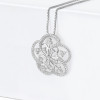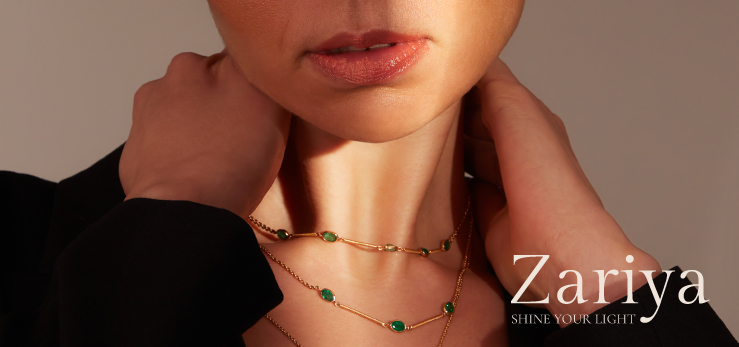What is a hallmark?
What is a hallmark? How do you read silver hallmarks? Does gold plated jewellery has a hallmark? Whether you identifying an old piece of jewellery or looking for quality assurance as you buy a new piece, read this feature first. This article will answer your questions about hallmarks on precious metals.
A hallmark is a stamp on a piece of precious metal. It is there for the purpose of consumer protection – your assurance of quality.
In the fourteenth century, Edward I decreed that all silver must be of “sterling” standard – a minimum of 925 parts silver per 1000, or 92.5% pure. Gold had to reach the Paris standard (19 carats). He appointed guardians to monitor silver and goldsmiths accordingly.
In 1327, the Goldsmiths’ Company started to put a hallmark on silver and gold from the very first assay office – the London Assay Office. Their stamp depicted a leopard’s head. By 1773, jewellery manufacture had grown substantially. Jewellers in Birmingham and Sheffield wanted to open new assay offices – which the Goldsmiths’ Company opposed. They lost their appeal and the new offices were opened.
In Edinburgh, the hallmark depicted Edinburgh castle; in Birmingham, an anchor; and in Sheffield, a crown.
Several others – such as Exeter, Glasgow and York – opened but later closed, leaving the four main offices to continue handling UK hallmarking.
It is worth noting that many Scottish and Irish silversmiths did not send their pieces to the regional offices for hallmarking. Tey instead marked their jewellery with their own stamps and sometimes the word “Sterling”. Many of these pieces are collectable due to their rarity.
All jewellery made in the UK – if it contains more than the threshold of precious metal – must now legally be hallmarked.
So take a look for a line of tiny symbols somewhere on your piece of jewellery. This is the hallmark – your assurance that the jewellery reaches an acceptable standard. It tells you (in code) who made it, what it was made from, and where it was checked. It may also carry the year it was made.
If your jewellery is old, you might need to consult an expert to read the hallmarks. There is a huge range of letters and symbols coming from different parts of the UK. While the modern hallmarks are simpler to decode, an old piece of jewellery could carry a long and complicated hallmark.
Jewellery under a minimum weight is exempt from hallmark law. But all jewellery above these weight thresholds (below) must legally be hallmarked with the maker’s mark, the metal and fineness, and the assay office that has certified it.
Silver fineness is measured in parts per thousand. So sterling silver has 925 parts pure silver per thousand; finest silver (used mainly in bullion bars, because it is very soft) has 999. Te accepted silver hallmarks, at time of writing, are:
800
925 (Sterling)
958 (Britannia)
999
These numbers will appear within an oval (indicating silver) in modern hallmarking.
In 1697, parliament raised the silver standard to 958 (Britannia), partly in order to combat the melting of sterling silver coins (which were being repurposed to make jewellery). Coins could no longer be used to make silver jewellery, but silversmiths did not approve of the change – because Britannia silver is softer than sterling. The standard was quite soon revised again, and sterling silver was returned to rule.
Today, the four main assay offices stamp jewellery with their own hallmarks:
London – Leopard
Edinburgh – 3-turret Castle
Sheffield – Rose
Birmingham – Anchor
As well as a symbol for the Assay office and a mark for the Maker, hallmarked silver will also include a date symbol – or row of symbols. Click on the links below to see a chart of the data symbols for your chosen Assay Office.
London silver hallmark letters (dates)
Birmingham silver Hallmark letters (dates)
Sheffield silver hallmark letters (dates)
Edinburgh silver hallmark letters (dates)
Gold plated jewellery is not legally hallmarked.
But real gold jewellery starting at 9ct, and weighing more than 1 gram, should legally be hallmarked.
Te fineness hallmark is the key piece of information for modern jewellery buyers. Gold fineness is measured in parts or carats, and the numbers you will find in a hallmark are:
375 (9 carats)
585 (14 carats)
750 (18 carats)
916 (22 carats)
990
999 (24 carats)
What do the gold hallmark numbers mean? The numbers indicate parts of pure gold per thousand. So 9-carat gold is 37.5% pure gold, and 24-carat gold has 99.9% pure gold. The gold fineness number will appear inside a symmetrical plaque shape. This is the symbol to indicate gold.
To recap, silver and gold hallmarks usually comprise:
1 – Assay office mark (a single symbol – look for the leopard, castle, crown or anchor).
2 – Maker’s mark (two letters inside a border).
3 – Fineness symbol or number (inside a shape that indicates the type of metal).
4 – Date symbol (pictorial or a letter) – this is now optional in the UK.
If your piece is stamped with a complicated hallmark, we recommend bringing your jewellery in for a professional valuation. We will be able to assess the quality of gemstones and identify the hall-
marks on your gold or silver jewellery.
Need help identifying your silver or gold hallmarks? Contact us to discuss our valuation service.
By law, all jewellery that has precious metal in it is required to be hallmarked by the Assay Office. However, there are certain weight thresholds that also decide whether or not your jewellery is required to be hallmarked. If the weight of jewellery falls below: 1 Gram (for gold and palladium), 7.78 Grams (for silver), and 0.5 Grams (for platinum), you can opt-out from hallmarking.
Jewellery which is made in gold, starts at 9Ct and is more than 1 gram, is compulsorily required to undergo hallmarking.
The cost of hallmarking depends on several factors. If there are one or two articles, they cost 14 per packet. If there are 3 or more articles, they cost 18 per packet + 1.10 (per article). The cost includes the traditional fineness symbol, sponsor’s mark, date letter, laser application of hallmark and the handling. The cost of hallmarking is usually borne by the jeweller/manufacturer.
The costs will differ on additional services added. Metal bars can also be hallmarked. The Goldsmith’s Company Assay Office releases an updated price list every year.
The fineness of a metal is a representation of the amount of alloy and pure metal in a piece of metal or jewellery. 925 is the representation of sterling silver or 92.5% silver. It means that the item has 92.5% pure silver and 7.5% alloy added. The alloy is added to reach a desired strength and durability. However, just because an item is only stamped with the numbers 925 does not mean it is hallmarked. For a piece to be hallmarked it should not only have the metal fineness but also the stamp of maker, an assay office mark and date/year it was hallmarked in. Please note that 925 is only used for silver. Gold jewellery’s fineness is never represented by the term 925.
Gold plated pieces are required to be hallmarked only if they use precious metal as their base metal and they fall under the required weight for an object to be hallmarked. Silver jewellery is often plated with gold. In this case, the jewellery must weigh more than 7.78 grams of silver. The Assay Office also remarks that “The gold plated layer must be of fineness of at least 375 parts per thousand and should not exceed 2 microns in thickness.”
































